SUN AN’ SOUL - DREAM AN’ ROME
SACRED AREA OF LARGO ARGENTINA
 |
| Sacred Area of Largo Argentina -
click to enlarge |
The Sacred Area of Largo Argentina was uncovered during demolition works begun in 1926 in the district bounded by via del Teatro Argentina, via Florida, via St. Nicola de' Cesarini and corso Vittorio.
| Sacred Area of Largo Argentina -
click to enlarge |
 |
 |
| Torre del Papito |
Teatro Argentina |
Four temples are visible to this day, fronting onto a paved square.
Given the uncertainty of their identification they ave been labelled with the first 4 letters of the alphabet.
Towards the end of the IV century BC was constructed the temple C, probably dedicated to Feronia, ancient Italic goddes of the harvest.
| Sacred Area of Largo Argentina -
click to enlarge |
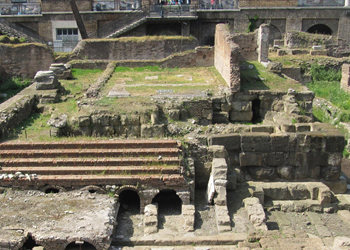 |
| Temple C |
Temple A, dedicated to Giuturna, was built mid way through III century. Temple D, most of which lays under via Florida, dedicated to Lari Piermarini patrons of sailors, was added at the start of II century BC.
| Sacred Area of Largo Argentina -
click to enlarge |
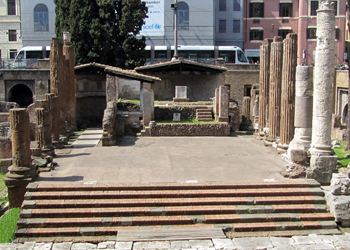 |
| Temple A |
Finally was built the temple B, dedicated to Fortuna Huiusce diei (the goddess of fortune of the present day).
| Sacred Area of Largo Argentina -
click to enlarge |
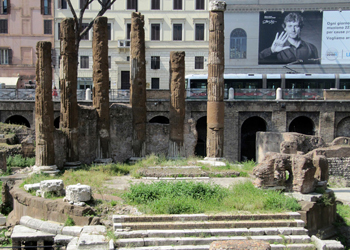 |
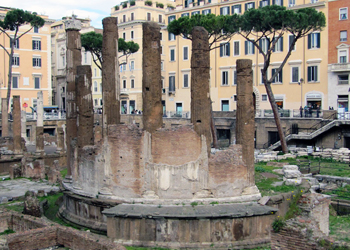 |
| Temple B |
Following a lot of fires the area was rebuilt many times,until in 107 BC Consul Minucius Rufus gave it an unified appearance wich took the name of “Porticus Minucia Vetus”.
Behind the temple B there is the exedra of Pompey's portico where sometimes gathered the Senate. Here the 15 March 44 BC Julius Cesar was assassinated.
Between temple A and B shortly after 50 BC was constructed the Statio Aquarum the office deputed to distribute the water in the city of Rome.
| Sacred Area of Largo Argentina -
click to enlarge |
 |
 |
| Exedra of Pompey’s portico |
Statio Aquarum |
But in 80 AD most of the Campus Martius, including this area, was burnt to the ground, then the Emperor Domiziano rebuilt the Sacred Area, paving the square with travertine slabs; the temples were restoredand the portico too, and this is what we see today.
| Sacred Area of Largo Argentina -
click to enlarge |
 |
| Portico |
Inside the impressive museum realized into the Montemartini discarde plant , are exhibited sculptures coming from the Sacred Area of Largo Argentina.
Memorable is the devotional statue in the Temple of Fortuna Huiusce Diei which is an acrolith, with the uncovered parts in marble, the drapes in bronze and the structure in wood. The sculpture was meant to be 8 meters high, according to the temple's proportions.
The colossal fragments of the statue, such as the head,
the right arm
and the feet
date back to 101 BC, when the temple was founded. The work has been attributed to Skopas Minor, a Greek artist based in Rome.
| Sacred Area of Largo Argentina -
click to enlarge |
 |
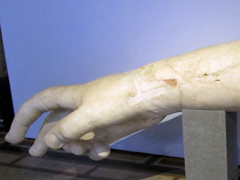 |
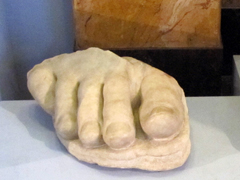 |
| Fragments of the devotional statue in the Temple of Fortuna Huiusce Diei |
Again from the Sacred Area come: the portrait of Plato,
Roman copy after the renwed portrait-sculptot Silanion (the original has been lost);
the head of Ares,
Severian replica (late II century AD), inspired by the bronze original cast by Alkamenes in 420 BC (lost).
| Sacred Area of Largo Argentina -
click to enlarge |
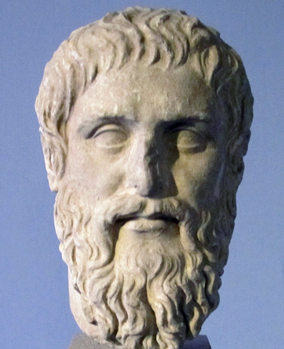 |
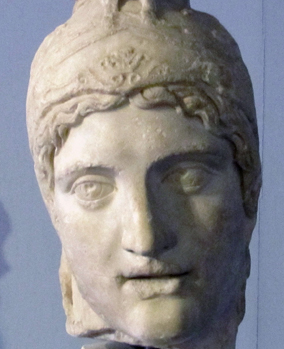 |
| Portrait of Plato |
Head of Ares |
back |

